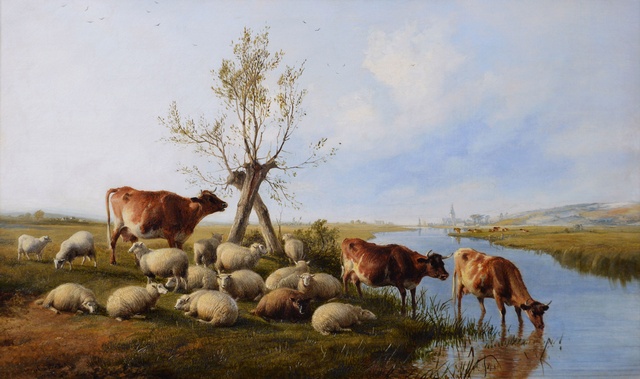Thomas Sidney Cooper
British, (1803-1902)Canterbury Meadows
Oil on canvas, signed & dated ‘T. Sidney Cooper RA/1894
Thomas Sidney Cooper was born in St Peter's Street Canterbury on 26 September 1803 to William and Sarah Cooper. He was christened Thomas Cooper and at some point adopted Sydney or Sidney as his middle name. At the age of 12 he started working as a coach painter and later a scene painter, continuing to draw and paint in his spare time.
When he was 21 he was helped by his uncle to move to London and study at the Royal Academy. However, he didn’t complete the course and returned to Canterbury. Shortly afterwards in 1824, he travelled to Brussels where he met Eugčne Joseph Verboeckhoven who had a great influence on his work. He also met and married Charlotte Pearson the daughter of a mathematician. After the revolution broke out they returned to London in 1831 where Cooper started selling paintings of the cattle that he sketched at Smithfield Market. The couple lived at Portland Terrace, St John’s Wood and together had four children. His son Thomas George Cooper (1836-1901) became an artist and also his great nephew William Sidney Cooper (1854-1927) both of whom he taught.
In 1833 he made his debut at the Royal Academy, where he continued to exhibit regularly until his death. He also exhibited at the Royal Society of British Artists and the British Institution between 1833 and 1863. He was elected ARA in 1845 and RA in 1867. From the early 1840’s he lived at 16 Wellington Terrace, until the 1850’s when he moved to 2 Dorset Square, Regent’s Park. He continued to live there for over 10 years until he moved to 42 Chepstow Villas, Bayswater. Around 1849, he had a second house built in Harbledown, Canterbury and named it Vernon Holme after his patron and from where he would also paint and exhibit.
Cooper specialised in paintings of cattle or sheep, which earned him the nickname of 'Cow Cooper'. He became one of the most accomplished and successful animal landscape painters of the 19th century. He built Alms Houses in Canterbury and in 1882 set up the Canterbury Sidney Cooper School of Art. In July 1901, he was awarded the Commander of the Royal Victorian Order (CVO). Cooper died at Harbledown, Canterbury on 7 February 1902 and was buried at St Martin Churchyard.
Examples of his work can be found at the Royal Museum in Canterbury, Tate Gallery, Victoria and Albert Museum, Atkinson Art Gallery, Birmingham Museum, Brighton and Hove Museum, Northampton Museum Sheffield Museum and other public collections.
Canterbury Meadows was a subject he painted on many occasions and would have known very well. With the River Stour running through it, the location provided local farmers with the ideal grazing ground and watering for their cattle and sheep. The church in the distance with its distinctive spire is most likely to be the church of St Mary the Virgin at Fordwich which still stands today.
| Presentation | The painting is housed in a new, English made gilt frame which is in excellent condition. |
| Condition | As with all of our original antique oil paintings, this work is offered in ready to hang gallery condition, having just been professionally cleaned, restored and revarnished. |
| Image Size | 14.75 inches x 24.75 inches (37.5cm x 63cm) |
| Framed Size | 21.5 inches x 31.5 inches (54.5cm x 80cm) |



